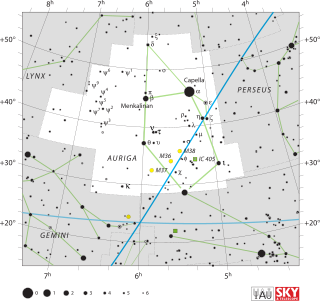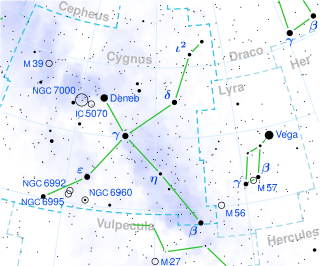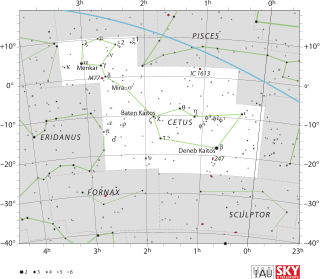
Nu2 Sagittarii (ν2 Sagittarii) is a binary star system in the zodiac constellation of Sagittarius. It is faintly visible to the naked eye, having an apparent visual magnitude of +4.98; it is 0.16 degree north of the ecliptic. The annual parallax shift of 11.91 mas as seen from Earth, indicates this system is roughly 270 light years from the Sun. Nu2 Sagittarii has a high peculiar velocity of 86.0+11.6
−14.4 km/s and is most likely a runaway star system.

Delta Aurigae, Latinized from δ Aurigae, is the Bayer designation for an astrometric binary star in the northern constellation of Auriga. It is visible to the naked eye with an apparent visual magnitude of 3.715. Based upon its annual parallax shift of 23.06 mas, it is some 141 light-years distant from the Earth, give or take a three light-year margin of error. It is drifting further away with a radial velocity of +10 km/s. This star is the namesake for the Delta Aurigids, a meteor shower that occurs between October 6–15. The radiant point for this shower passes several degrees to the south of the star.

Nu Aurigae, Latinised from ν Aurigae, is the Bayer designation for a star in the northern constellation of Auriga. It is visible to the naked eye with an apparent visual magnitude of 3.96 and is approximately 220 light-years distant from the Earth. This is an evolved giant star with a stellar classification of G9.5 III. It is a red clump star, which indicates that it is generating energy through the fusion of helium at its core. The outer envelope has expanded to 19 times the radius of the Sun and cooled to 4,571 K, giving it the characteristic yellow-hued glow of a G-type star. It shines with 135 times the luminosity of the Sun.
24 Aquilae is a star in the equatorial constellation of Aquila. 24 Aquilae is its Flamsteed designation. It is located at a distance of around 434 light-years from Earth and has an apparent visual magnitude of 6.4. According to the Bortle Dark-Sky Scale, this star is just visible to the naked eye in dark rural skies. It is drifting closer to the Sun with a radial velocity of −26 km/s.

Mu Aurigae, Latinized as μ Aurigae, is the Bayer designation for an unconfirmed binary star in the northern constellation of Auriga. It is visible to the naked eye with an apparent visual magnitude of +4.88. Based upon an annual parallax shift of 20.7218±0.4971 mas as seen from Earth, is located 157 light-years from the Sun.

1 Aurigae is the original name for a star now in the constellation Perseus. It was the first entry in John Flamsteed's catalogue of stars in Auriga. When Eugène Joseph Delporte drew up simplified boundaries for the constellations on behalf of the International Astronomical Union in 1930, 1 Aurigae ended up over the border in Perseus. To avoid confusion, the star may instead be referred to by its Harvard Revised catalogue number, HR 1533.

Phi Aurigae, Latinized from φ Aurigae, is a giant star in the northern constellation of Auriga. It is faintly visible to the naked eye with an apparent visual magnitude of 5.089. It lies 10′ from another faint naked-eye star HD 35520, between the three open clusters M36 and M38, and NGC 1893.
65 Aurigae is a binary star system located 252 light years away from the Sun in the northern constellation of Auriga. It is visible to the naked eye as a faint, orange hued star with an apparent visual magnitude of 5.12. The primary, designated component A, is an aging giant star with a stellar classification of K0 III. It is 3.31 billion years old and has expanded to 13 times the Sun's radius after exhausting the hydrogen at its core. Its companion, component B, is a magnitude 11.7 star located at an angular separation of 11.4″ from the primary, as of 2008. The pair are moving further from the Earth with a heliocentric radial velocity of 22 km/s.

AR Aurigae, also known by its Flamsteed designation 17 Aurigae, is a binary star in the constellation Auriga. Based on parallax measurements made by the Hipparcos spacecraft, it is approximately 461 light-years from Earth.
5 Canum Venaticorum is a probable binary star system in the northern constellation of Canes Venatici, located about 375 light years from the Sun. It is visible to the naked eye as a faint, yellow-hued star with an apparent visual magnitude of +4.77. The system is moving closer to the Earth with a heliocentric radial velocity of −14 km/s.

Zeta Cygni is a binary star system in the northern constellation of Cygnus, the swan. It has an apparent visual magnitude of 3.26 and, based upon parallax measurements, is about 143 light-years away.

Xi1 Ceti , Latinized from ξ1 Ceti, is a binary star system located in the equatorial constellation of Cetus. It is visible to the naked eye with a combined apparent visual magnitude of +4.36. The distance to this system is approximately 340 light years based on parallax measurements, and it is drifting closer to the Sun with a radial velocity of −4 km/s. The proximity of the star to the ecliptic means it is subject to lunar occultations.
HD 20644 is a suspected binary star system in the constellation Aries. It has an orange hue and is visible to the naked eye with an apparent visual magnitude of 4.47. The system is located at a distance of approximately 540 light years from the Sun based on parallax, but is drifting closer with a radial velocity of −3 km/s.
HD 91190 is a suspected astrometric binary star system in the northern circumpolar constellation of Draco. It is faintly visible to the naked eye, having an apparent visual magnitude of 4.86. The distance to HD 91190, as estimated from its annual parallax shift of 4.5 mas, is around 720 light years. This system is moving further away from the Sun with a heliocentric radial velocity of +17 km/s, having come to within 170 ly some 2.4 million years ago.
Chi Geminorum is a binary star system in the constellation Gemini, near the western border with Cancer. It can be viewed with the naked eye on a dark night, having an apparent visual magnitude of 4.98. Based upon an annual parallax shift of 12.73 mas, it is located roughly 260 light years from the Sun.
26 Hydrae is a binary star system located 334 light years away from the Sun in the equatorial constellation of Hydra. It is visible to the naked eye as a faint, yellow-hued point of light with a combined apparent visual magnitude of 4.77, just a few degrees away from Alphard. The system is moving closer to the Earth with a leisurely radial velocity of -1 km/s.
7 Piscium is a single star in the zodiac constellation of Pisces, located around 343 light-years away from the Sun. It has the Bayer designation b Piscium; 7 Piscium is the Flamsteed designation. This object is visible to the naked eye as a faint, orange-hued star with an apparent visual magnitude of 5.07. It is moving further from the Earth with a heliocentric radial velocity of 40 km/s.
5 Ursae Minoris is a star in the circumpolar constellation of Ursa Minor. It is a faint star but visible to the naked eye with an apparent visual magnitude of 4.253. The distance to this star, as determined from an annual parallax shift of 9.09±0.13 mas, is about 110 pc. It is moving further away with a heliocentric radial velocity of +9 km/s.
8 Persei is a single star in the northern constellation of Perseus, located 416 light years away from the Sun. It is visible to the naked eye as a dim, orange-hued star with an apparent visual magnitude of 5.757. There is an estimated 52% chance that the star may be a member of the Hyades–Pleiades stream of co-moving stars.
16 Serpentis is a binary star system in the Serpens Caput portion of the equatorial constellation of Serpens, located 228 light years from the Sun. It is visible to the naked eye as a fain, orange-hued star with an apparent visual magnitude of 5.261. The system is moving further from the Earth with a heliocentric radial velocity of +3 km/s.








